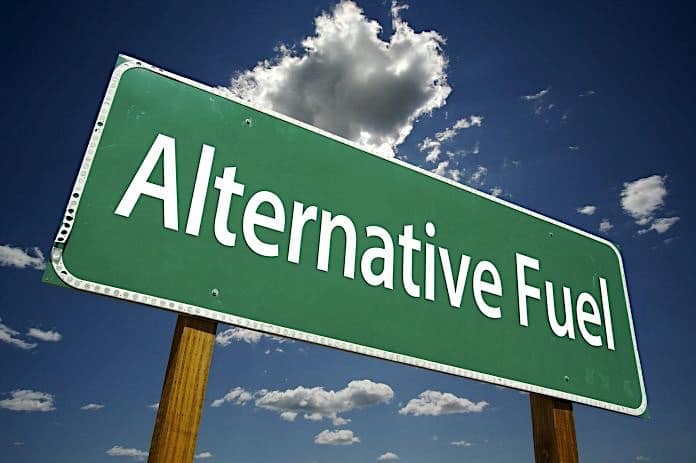The majority of school buses in America run on diesel fuel, but those engines are far different today than the ones decades ago that spewed forth dark, black clouds of soot from the exhaust.
Estimates are that about 85- to 90 percent of the national fleet of 480,000 school buses still run on diesel, with the remainder split between gasoline and alternative fuels. Informal surveys conducted by School Transportation News indicate that the most widely-used alternative fuel is propane. It’s important to note that biodiesel, which commonly range in regular diesel-blend amounts from 2 percent to 20 percent, while commonly produced from soybeans is not a standalone fuel because it complements diesel. Therefore, it is also not classified as an alternative fuel
Propane has gained ground over the past several years, especially in Texas, where the Texas Railroad Commission has introduced big incentives. Originally, propane was looked down upon by school bus operators because the system was installed as an aftermarket kit. That changed when Blue Bird introduced its Type C Vision in 2008. Blue Bird unveiled its second-generation Vision Propane-Powered School Bus during the 2011 STN EXPO in Reno, Nev. Watch a Jan. 19, 2011 webinar presented partner ROUSH CleanTech, which provides the propane auto-gas system that works with a Ford engine, on the technical aspects of the Vision as well as a history on propane. Thomas Built Buses also announced in November of 2010 that it would also make available a propane model power by Powertrain Integration PythonLI, which is now available on the marketplace. Interestingly, propane engine manufacturer Power Solutions International purchased Powertrain Integration in 2015, shortly after becoming the propane partner to IC Bus.
CNG appears to be the next-most commonly used alternative fuel for school buses, especially in places like California where the Air Resources Board has required for the past two decades that all new school bus purchases be of the CNG variety. CNG has traditionally been more prevalent on the West Coast, but in recent years the fuel has expanded to the Midwest. Two of the three manufacturers of large school buses (Blue Bird Corporation and Thomas Built Buses) offer CNG options, and a third manufacturer (Starcraft) has said it would offer a CNG Type A school bus in 2011.
On the small school bus front, Blue Bird developed a similar propane system for its Type A Micro Bird that runs on a ROUSH CleanTech system developed for the Ford E-450 chassis. Competitor Collins Bus Corporation was the first Type A school bus manufacturer to introduce propane with its solution for the Chevrolet Express and GMC Savana 3500 and 4500 van cutaway chassis, in partnership with Clean Fuels USA. Since, GM announced that it will offer propane power to all Type A school bus manufacturers that build on their built on the Chevrolet Express and GMC Savana 4500 series chassis with Vortec 6.0L engines. Plans to extend the offer to 3500 series chassis was in the works. Collins Bus also announced in late 2011 that it would offer the first CNG option for Type As alongside clean energy partner BAF.
Hybrid and plug-in electric vehicles also made their way onto the scene several years ago but have since all but vanished due to price, infrastructure, battery and supply-chain challenges. In 2014, there were less than 1,000 hybrid or plug-in electric vehicle (PHEV) school buses in use nationwide, with the largest fleet in Wisconsin as two school bus contractors combined to run 25 of these vehicles. IC Bus introduced the first PHEV school bus in 2006. The subsidiary of Navistar offered the PHEV using an Enova Systems drive solution and a charge-sustaining hybrid model utilizing an Eaton system. Thomas Built Buses, meanwhile, offered a charge-sustaining hybrid-electric option in partnership with Eaton, and Collins Bus offers the hybrid option for its Type A NexBus on a Ford E-450 chassis with technology from Azure Dynamics Corporation. Since, both OEMs have walked away from their hybrid projects.
However, nearly all school bus manufacturers have embraced zero-emissions electric drivetrains, including Lion Bus with its Type-C eLion and Trans Tech Bus with its SSTe in partnership with motive. But cost is also an issue, and as of this report only the Kings Canyon Unified School District in California and a handful of school boards in Quebec were using them. Reportedly several orders of electric school buses are arriving at California school districts in August 2016. Additionally, ADOMANI is working with Blue Bus Corporation and unveiled a Type D All American Electric prototype at the 2017 STN EXPO. Blue Bird and ADOMANI are also partnering on a Type C VIsion Electric, with both buses expected to be production ready by the end of 2018. Meanwhile, the Micro Bird Type A brand also offers an all-electric model.
Thomas Built Buses and IC Bus also unveiled their own all-electric prototypes in late 2017, with production versions expected in late 2019 or 2020.
GreenPower also offers an all-electric Type D school bus as of 2018. Prior, the company and A-Z-Bus Sales, Inc. partnered on a project to retrofit old diesel school buses to run on electric, and the Torrance Unified School District in Southern California has been working with funds from the Clinton Global Initiative since 2014 to prepare two electric school buses for service.
















